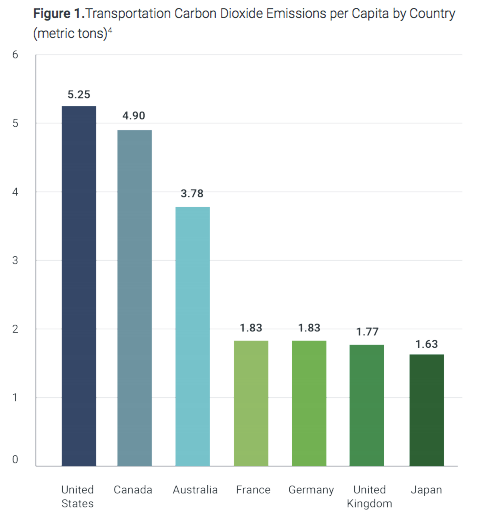
To do its part to avert catastrophic climate change, the United States would have to more or less eliminate carbon emissions from transportation in the next 35 years. But America is nowhere near on pace to make that happen.
Transportation recently overtook the electric power sector to become the nation's largest source of carbon emissions. That's what you would expect out of a transportation policy framework that prioritizes cars, highways, and sprawl -- and hasn't changed very much in 60 years, despite some recent tinkering around the margins.
The U.S. Public Interest Research Group and the Frontier Group are out with a new report [PDF] outlining 50 steps to eliminate carbon pollution from the American transportation sector by incentivizing low-carbon modes of travel, more efficient development patterns, and cleaner vehicles. Here are three of the most important steps.
First step -- get a grip on the damage being done
America is basically flying blind when it comes to charting a greener course for transportation emissions -- we have no idea how all the money spent on transportation infrastructure affects the climate. Only in a handful of states do transportation agencies even consider how their very expensive highway projects lead to more greenhouse gas emissions.
The federal government is at least moving to require transportation agencies to measure their carbon impacts. This is a good first step in imposing some kind of accountability.
But measuring is just the first step, of course. Real change will happen only when the goal of reducing carbon emissions permeates every transportation policy decisions at the federal and state level.
Quit subsidizing highways and driving
As long as driving is subsidized to the tune of tens of billions of dollars a year, resource-intensive sprawl will have the upper hand over cleaner modes of travel and more efficient development patterns. We have a long way to go to get these incentives right.
U.S. PIRG reports that in 2014, $98 billion from sources like general fund revenues and sales taxes -- which don't come from drivers -- were directed toward highway projects. So nearly a hundred billion dollars in annual subsidies for roads.
At the federal level, the authors recommend eliminating the ban on tolling existing interstate highway lanes, so drivers pay for the infrastructure they use.
They also recommend leveling the playing field for highway and transit projects. Currently, government spends about four times as much on highways as transit.
And they target the federal commuter tax benefit for parking, which amounts to a $7.3 billion annual subsidy for solo car commuting.
Major changes are needed at the state level as well. The constitutions of 23 states forbid spending state gas tax funds on anything other than highways. Many states provide practically no budget support for walking, biking, or transit. In 2014, 24 states spent less than 1 cent per capita per day on transit.

Link transportation and development policies to create more walkable places
Public policies at every level of government favor the construction of car-centric suburban environments over the walkable, bikeable communities that can help reduce reliance on fossil fuels. This is not just a matter of transportation policy, but of land use and development incentives too.
To better align the built environment with sustainability goals, the authors recommend doing away with housing subsidies that tilt the market toward large-lot, single-family homes and discourage mixed-use development. State and local tax breaks that lead to job sprawl without actually creating jobs also need to go.
Coordinating transportation and development policies should be a core tenet at every level of government. Transportation projects should be selected based on how they affect land use, for instance, while housing and development subsidies should be targeted in transit-accessible areas. The classic American highway project enabling greenfield sprawl has to give way to a new standard of investment that prioritizes transit and walkability.





